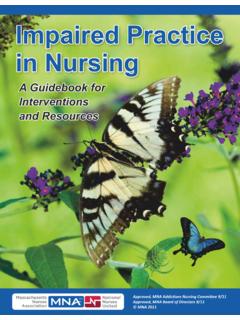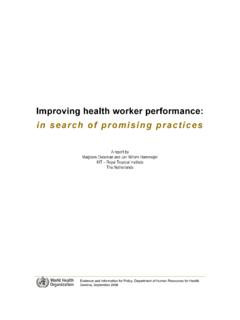Transcription of Evidence-Based Psychosocial Interventions for …
1 Evidence-Based Psychosocial Interventions for hispanics : research and Policy Implications Luis R. Torres, PhD. Evidence-Based Practice: Definitions and an Example What is Evidence-Based Practice? Initially a term used primarily in medicine, Evidence-Based practice (EBP) is now central to the fields of education, child welfare, mental health, criminal justice, and many other fields of practice and service There are several definitions of Evidence-Based Practice emerging from these various fields, and all are variations of each other. Three key definitions are those put forth by the Institute of Medicine (IOM), the American Psychological Association (APA), and the National Association of Social Workers (NASW).
2 The IOM defines Evidence-Based medicine as the integration of best researched evidence and clinical expertise with patient values, 2 while the APA defines Evidence-Based practice in psychology as the integration of the best available research with clinical expertise in the context of patient characteristics, culture, and preferences. 3 Meanwhile, the NASW defines Evidence-Based social work practice as a process involving creating an answerable question based on a client or organizational need, locating the best available evidence to answer the question, evaluating the quality of the evidence as well as its applicability, applying the evidence, and evaluating the effectiveness and efficiency of the solution.
3 1 These definitions all emphasize three important components that we will discuss in short order: the central role of empirical support or research , Evidence-Based practice as a process in addition to a finished product, and the importance of attending to patient characteristics including culture and context. From Evidence-Based Practice to Evidence-Based Interventions Evidence-Based practice is not new: practitioners have long used current scientific knowledge to support their assessment and intervention What has changed, however, is that third-party payers, as well as policy and funding entities, are now increasingly expecting, and in some cases demanding, that Evidence-Based Interventions be used as a requirement for payment or Providers in medicine, human services, and social services are under increasing pressure to select treatment Interventions with empirical support for positive outcomes.
4 Whether it be for cancer or depression treatment, enhancing parenting or relationship functioning, preventing drug use, unplanned pregnancies, or HIV transmission, or increasing self-esteem or high school completion rates, service providers are under increasing pressure to select Interventions that work ( , to select and implement Evidence-Based Interventions ). Researchers are also under increasing scrutiny to include Evidence-Based Interventions in their grant applications, and funding decisions are increasingly being tied to the selection and use of Evidence-Based Interventions . Consumers of services have also embraced the Evidence-Based movement and expect the best treatment evidence can provide.
5 The Internet has made accessing information as easy as opening up a browser and entering a search term in a search engine. Even the most sophisticated information, previously available only to providers, is now available to consumers with the click of a mouse. When a client goes to see a provider for the first time, chances are that the client has done her homework and has already researched her symptoms and has specific questions to ask the provider. Evidence-Based Psychosocial Interventions for hispanics : research and Policy Implications 1. It is not uncommon these days for a client to tell the provider this is the treatment I want because I.
6 Read online that it's the best treatment for my symptoms.. These are important developments to be sure. An emphasis on continuously questioning and searching for new and better evidence, and a move toward using Interventions with evidence of success, can only make our services better. However, a blind embracing of the Evidence-Based movement is not without risk, and we will discuss some of these risks shortly. An Example of the Evidence-Based Movement: SAMHSA's Strategic Prevention Framework The Substance Abuse and Mental Health Services Administration's (SAMHSA) Strategic Prevention Framework (SPF) is a five-step planning process that guides the work of states and communities in their substance abuse prevention activities.
7 The third and fourth step in the process calls for developing a comprehensive strategic plan that outlines Evidence-Based programs, practices, and policies to address the needs of the target community, and to implement the outlined Evidence-Based programs, practices, and Since funding priority is given to programs that select Evidence-Based Interventions , SAMHSA also provides guidelines for the selection of Evidence-Based Interventions (see Table 1. below). Table 1. Summary of Evidence-Based Guidelines used by SAMHSA and APA. SAMHSA's Strategic Prevention Framework 1. Inclusion in Federal registries of Evidence-Based Interventions .
8 2. Reported in peer-reviewed journals, with positive effects on the primary targeted outcome. 3. Documented effectiveness of the intervention, supported by other sources of information and the consensus judgment of informed experts, as described in four guidelines, all of which must be met. a. based on a theory of change that is documented in a clear logic or conceptual model. b. Similar in content and structure to Interventions that appear in registries and/or the peer- reviewed literature. c. Supported by documentation that it has been effectively implemented in the past, and multiple times, in a manner attentive to scientific standards of evidence and with results that show a consistent pattern of credible and positive effects.
9 D. Reviewed and deemed appropriate by a panel of informed prevention experts that includes well- qualified prevention researchers who are experienced in evaluating prevention Interventions similar to those under review; local prevention practitioners; and key community leaders as appropriate ( , officials from law enforcement and education sectors or elders within indigenous cultures). American Psychological Association Task Force Criteria for Evidence-Based Treatments Well-Established Treatments 1. At least two good group-design experiments, conducted in at least two independent research settings and by independent investigatory teams, demonstrating efficacy by showing the treatment to be superior to pill or psychological placebo or to another treatment, OR equivalent to (or not significantly different from) an already established treatment in experiments with statistical power being sufficient to detect moderate differences.
10 2. Use of treatment manuals or logical equivalent in the treatment. 3. The treatment was conducted with a population, treated for specified problems, for whom inclusion criteria have been delineated in a reliable, valid manner. Evidence-Based Psychosocial Interventions for hispanics : research and Policy Implications 2. 4. Use of reliable and valid outcome assessment measures, at minimum measuring the problems targeted for change. 5. Use of appropriate data analyses. Probably Efficacious Treatments 1. At least two experiments showing the treatment is statistically significantly superior to a wait-list or no treatment control group, OR one or more experiments meeting the Well-Established Treatment Criteria (they do not need to have been conducted in at least two independent research settings and by independent investigatory teams).








